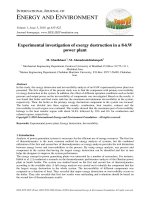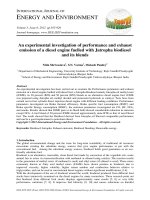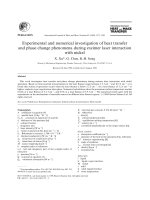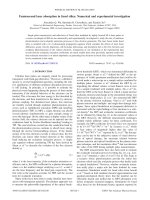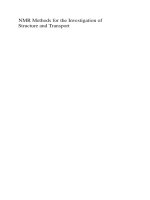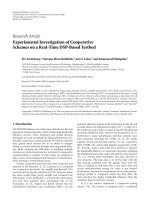Numerical and experimental investigation of single and two phase impinging jet heat transfer
Bạn đang xem bản rút gọn của tài liệu. Xem và tải ngay bản đầy đủ của tài liệu tại đây (4.92 MB, 192 trang )
NUMERICAL AND EXPERIMENTAL
INVESTIGATION OF SINGLE AND TWO-PHASE
IMPINGING JET HEAT TRANSFER
ZHENGQUAN LOU
NATIONAL UNIVERSITY OF SINGAPORE
2007
NUMERICAL AND EXPERIMENTAL
INVESTIGATION OF SINGLE AND TWO-PHASE
IMPINGING JET HEAT TRANSFER
ZHENGQUAN LOU
(Bachelor, SJTU)
A THESIS SUBMITTED
FOR THE DEGREE OF DOCTOR OF PHILOSOPHY
DEPARTMENT OF MECHANICAL ENGINEERING
NATIONAL UNIVERSITY OF SINGAPORE
2007
i
Summary
Impinging jet heat transfer is one of the flow techniques used to cool or heat the
target surfaces by fluid impingement on them. It is widely used in industrial applications
ranging from drying of textiles and films, metal sheet manufacturing, gas turbine cooling
to electronic component cooling. With the rapid increase of the heat dissipation in
electronic components, impinging jet technique becomes more important to cool the hot
chip.
The objective of the current research was to test the heat transfer performance of
impinging jet system under various boundary conditions. In this study, both numerical and
experimental methods were used to examine the single and two-phase problems. For the
single phase heat transfer, the effects of different boundary conditions and various
parameters, e.g. geometric parameters, Biot number, fin structure and presence of a baffle
in the jet flow, on the heat transfer performance were studied using a Computational Fluid
Dynamics (CFD) method. The parameters such as Nusselt number, thermal resistance and
heat flux, were obtained to evaluate the heat transfer performance of the impinging jet
system.
For the two-phase problem, a mixture model, incorporated with User Defined
Functions (UDFs), were used to simulate the process of heat transfer and mass transfer.
The current study discussed the effects of superheat of target plate, sub-cooled working
fluid and various inlet velocities on the two-phase heat transfer performance. Moreover,
visualization of two-phase process was obtained.
ii
Other than the simulation work, an experiment was set up to test the heat transfer
performance of single and two-phase problems with water and FC-72 as the working
fluids. The parameters, e.g. impingement orientation, jet width and inlet velocity, were
examined in the experiment. The simulation results and experimental results were
compared and a reasonable agreement was obtained. Finally, on the basis of the verified
simulation model, more predictions of two-phase micro-scale impinging jet were carried
out in view of its promising application in industry.
This dissertation addresses the numerical and experimental investigation of single
and two-phase impinging jet heat transfer. The goal of this study is to contribute to a more
detailed investigation of effects of various parameters on impinging jet heat transfer so as
to improve the design of the current impinging jet system.
In the current investigation, the relationships between the local Nusselt
number
x
Nu , average Nusselt number
m
Nu , jet width W , jet height
H
, WH / andRehave
been generalized. Also, the effects of subcooled water temperature, inlet velocity and
superheat temperature of target plate on the heat transfer performance have been obtained.
Distributions of temperature contour, velocity contour, velocity vector and volume
fraction of vapor are obtained. The effect of surface roughness on the two-phase
impinging jet heat transfer has also been examined. A dielectric fluid FC-72 has tested and
the comparison between FC-72 and water is carried out. The advantages of FC-72 in the
industrial application are reported.
iii
Acknowledgements
I would like to express my sincere gratitude to my supervisors, Professor Arun S.
Mujumdar and Assoc. Professor Christopher Yap, for their tremendous support and
patient guidance. I am deeply grateful for their critical and crucial suggestions and
comments on my research work. I am forever indebted to them for guiding me in the
research world of impinging jet heat transfer.
I would like to thank the lab officer of Air-conditioning Lab, Mr. Sacadevan Raghavan for
his kindness and enthusiastic help in the preparation of the experimental equipment. I
would also like to extend my thanks to my friends, Mr. Huang Lixin, Mr. Wang Shijun,
Mr. Wu Zhonghua, Mr. Wang Xiangqi and many others.
I am greatly obliged to my parents for their continuous supports from childhood to now.
Finally, I am also grateful to NUS for its financial support for my Ph. D program.
Zhengquan Lou
Singapore
December 2006
iv
Table of contents
Summary……………………………………………………………………………….…i
Acknowledgements………………………………………………………… ……………iii
Table of contents……………………………………………………………………… iv
Nomenclature……………………………………………………………………………vi
List of Figures………………………………………………………………………… viii
List of Tables…………………………………………………………………………….xii
Publications arising from this thesis…………………………………………………… xiii
Chapter 1 Introduction…………………………………………………………….… 1
1.1 Background…………………………………………………………………… …….1
1.2 Introduction of Impinging Jet Technique…………………………………… …….…9
1.3 Objectives ………………………………………………………………….… ……10
1.4 Scope……………………………………………………………….… ……11
Chapter 2 Literature Review………….…….……….……………………….… ……13
2.1 Geometric effect ……………………………………………………………………14
2.2 Conjugate Heat Transfer……………………………………………….……… …16
2.3 Fin Structure……………………………………………………………….… … …18
2.4 Effect of an Inserted Baffle ……………………………………………… …………21
2.5 Two-phase IJHT: Experimental Investigation……………………………… ………23
2.6 Two-phase IJHT: Numerical Investigation………………………………… ………27
Chapter 3 Fundamentals of Single and Two-phase IJHT…………………… ……34
3.1 Description of the Basic Impinging Jet System………………………………………34
3.2 Modeling of Single-phase Simulation………………………………………… ……36
3.3 Fundamental Theory of Boiling Heat Transfer………………………………….……37
3.4 Models for Multiphase Flow and Heat Mass Transfer…………………… …………42
3.5 General Guidelines of Model Selection………………………………………………46
3.6 Conservation Equations and Other Equations……………………………… ………48
3.7 User-Defined-Functions……………………… …………………………… ………50
Chapter 4 Effects of Geometric Parameters on Confined IJHT…………………… 52
4.1 Problem Description……………………………………………………….…………52
4.2 Calculation of Thermal Parameters ……………………………………….…………54
4.3 Results and Discussion……………………………………………………….………55
4.3.1 Effect of Jet Width W ………………………………………… ………….………56
4.3.2 Effect of Jet Height
H
………………………………………………… …………59
4.3.3 Effect of Jet Reynolds Number……………………………………………… ……61
4.3.4 Effect of Surface Roughness………………………………………………….……62
4.3.5 Effect of the Inlet Velocity Profile …………………………………………………65
4.4 Summary of Chapter… …………………………………………………………… 66
Chapter 5 Conjugate Heat Transfer under a Confined IJ……………………………68
5.1 Problem Description………………………………………………………………… 68
5.2 Results and Discussion……………………………………………………………… 70
5.2.1 Relationship between
x
Bi ,
m
Bi
and
p
k
…………………… ………………………70
v
5.2.2 Relationship between
x
Bi ,
m
Bi and
Nu
………………………………………… 75
5.2.3 Selection of Target Plate…………………………………………….………… …77
5.3 Summary of Chapter… …………………………………………………………… 77
Chapter 6 Simulation of Laminar IJHT to Finned Heat Sinks………………………79
6.1 Problem Description………………………………………………………….………79
6.2 Results and Discussion……………………………………………………….………83
6.2.1 Effect of Fin Number……………………………………………………….………83
6.2.2 Effect of Fin Height
f
H
……………………………………………………………86
6.2.3 Effect of Fin-to-spacing Ratio
ff
SW /
………………………………….…………89
6.3 Summary of Chapter… …………………………………………………………… 92
Chapter 7 Numerical Investigation of Baffle Effect on IJHT……………….… ……93
7.1Problem description …………………………………………………………….……93
7.1.2 Numerical Simulation………………………………………………………………94
7.1.3 Formulation of Parameters…………………………………………………………95
7.2. Results and Analysis…………………………………………………………………97
7.2.1 Orientation of Baffle……………………………………………………… ………97
7.2.2 Locations of Vertical Baffle……………………………………………… ……100
7.2.3 Locations of Horizontal Baffle……………………………………………………104
7.3. Summary of Chapter… ……………………………………………………………106
Chapter 8 Numerical Simulation of Two-phase IJHT…………………….…………108
8.1 Problem Description…………………………………………………………………108
8.2 Results and Discussion………………………………………………………………111
8.2.1. Effect of Subcooling………………………………………………………………112
8.2.2. Effect of Inlet Velocity
v
………………………………………………… ……114
8.2.3. Effect of Superheat Target Plate …………………………………………………119
8.2.5 Visualizations of the Volume Fractions of Vapor…………………………………124
8.2.6 Investigations of Micro-impinging Jet ……………………………………………128
8.2.7 Effect of Surface Roughness………………………………………………………133
8.3 Summary of Chapter… …………………………………………………………….136
Chapter 9 Experimental Investigation of Single and Two-phase IJHT……….……137
9.1 Experiment Setup and Procedure……………………………………………………137
9.2 Uncertainty of measurement………………………………………………… ……140
9.3 Results and Discussion ………………………………………………………… …143
9.3.1 Heat Transfer Results…………………………………………………………… 143
9.3.2 Orientation Effect of Impinging Jet System……………………………………….147
9.3.3 Effect of Jet Width……………………………………………………………… 154
9.3.4 Comparison between FC-72 and Water ………………………………………… 158
9.4 Summary of Chapter… …………………………………………………………….160
Chapter 10 Conclusions and Recommendations…………………………….………162
10.1 New Contributions…………………………………………… …………… ……164
10.2 Recommendations in the Future Work………………… …………………………164
References…………………………………………………… ……………….………166
Appendices……………………………………………… …………………….……175
vi
Nomenclature
b
A
Bottom surface area of the heat sink m
2
t
A
Top surface area of the heat sink m
2
0
Bi Local Biot number at the stagnation point
m
Bi
Average Biot number
x
Bi
Local Biot number
p
C Specific heat J/kg•K
f Friction factor
m
h
Average convective heat transfer coefficient W/m
2
•K
x
h
Local convective heat transfer W/m
2
•K
H Jet height mm
f
H
Fin height mm
f
k
Thermal conductivity of the working fluid W/m•K
p
k
Thermal conductivity of the target plate W/m•K
fin
k
Thermal conductivity of the plate-fin W/m•K
b
l Baffle length mm
L Target plate length mm
M flow rate ml/min
0
Nu
Nusselt number at the stagnation point
e
Nu
Effective Nusselt number
m
Nu
Average Nusselt number
P
Δ Pressure drop between inlet and outlet Pa
q Heat flux W/m
2
x
q
Local heat flux W/m
2
Re Reynolds number
μ
ρ
/uW
f
S Spacing between two adjacent fins mm
fin
T
Average temperature of the plate-fin K
w
T
Wall temperature the target plate K
u Inlet jet velocity m/s
W Jet width mm
f
W Fin width mm
b
w Width of the baffle mm
X Horizontal distance to the axis mm
Y Vertical distance to the target plate mm
vii
Greek symbol
α
Impingement orientation
δ
Target plate thickness mm
ρ
Fluid density kg/m
3
μ
Dynamic viscosity kg/m•s
υ
Kinematic viscosity m
2
/s
af
θ
Thermal resistance K/W
Subscripts
f
Working fluid
x Local
w Wall
m Mean (or average)
0 Stagnation point
viii
List of figures
Fig. 1.1 Heat transfer coefficient attainable with natural convection, single-phase liquid
forced convection and boiling for different coolants. 2
Fig. 1.2 A conventional design of an electronic cooling device by a heat sink 3
Fig. 1.3 A typical configuration of a heat pipe 4
Fig. 1.4 Geometric configuration of the micro-channel the heat transfer 5
Fig. 1.5 Geometric configuration of an impinging jet system 6
Fig. 1.6 Thermal resistance for various cooling fluids 6
Fig. 1.7 Flow chart of the current investigation of impinging jet heat transfer……… 12
Fig. 2.1 Classification of impinging jet heat transfer in term of various parameters… 13
Fig. 3.1a Geometric configuration of an impinging jet system………………………… 35
Fig. 3.1b An impinging jet system with a scheme of its vortex structure……………… 35
Fig. 3.2 Rising air bubble in water. Left:
−
x
Velocity versus time. Right: Shape and flow
field at 8=t for 32/ =hD . The contour shown for
,1210
−
=
α
2
1
, and,
12
101
−
− …… 44
Fig. 4.1 Schematic diagram of the impinging jet domain…………………………… 53
Fig. 4.2 Grid information of the right half computational domain the impinging jet
system 54
Fig. 4.3 Distributions of surface temperature along the plate with
WH /
as a
parameter ………………………………………………………………………….…… 57
Fig. 4.4 Distributions of local Nusselt numbers
x
Nu along the plate with WH / as a
parameter ……………………………………………………………………………… 57
Fig. 4.5 Relationship between pressure drop and
WH / .……………………………… 58
Fig. 4.6 Distributions of local Nusselt numbers
x
Nu along the plate with WH / as a
parameter ……………………………………………………………………………… 59
Fig. 4.7 Relationship between the local Nusselt numbers
x
Nu and WH / at the stagnation
area …………………………………………………………………………………… 61
Fig. 4.8 Distributions of local Nusselt number
m
Nu along the plate withRe as
parameter ………………………………………………………………………………62
Fig. 4.9 Correlation between the average Nusselt number
m
Nu , Reynolds number Re and
WH /
………………………………………………………………………………… 62
Fig. 4.10 Grid information of triangular, rectangular and sine roughness on the target
plate …………………………………………………………………………………….63
Fig. 4.11 Distributions of surface temperature along the rough target plate with Re =
80 ……………………………………………………………………………………….63
Fig. 4.12 Comparison of local Nusselt numbers for different inlet velocity profiles ….65
Fig. 5.1 Distributions of the surface temperature along the target plates for variable
p
k 71
Fig. 5.2 Distributions of heat flux
x
q along the target plate with variable
p
k ………… 71
Fig. 5.3 Distributions of the local Biot number
x
Bi for different material target plate . 72
ix
Fig. 5.4 Distributions of the local heat transfer coefficient for different material target
plate …………………………………………………………………………………….73
Fig. 5.5 Comparison between local and average Biot numbers for the aluminum target
plate …………………………………………………………………………………….73
Fig. 5.6 Correlations between local, average Biot numbers and thermal conductivities 74
Fig. 5.7 Distributions of local Nusselt numbers
x
Nu for variable Biot numbers along the
target plate ………………………………………………………………………………76
Fig. 5.8 Correlation between average Biot number and average Nusselt number …… 76
Fig. 6.1 Three dimensional configuration of the impinging jet system with a plate-fin heat
sink as the target plate ………………………………………………………………… 81
Fig. 6.2 Three dimensional mesh generation of the computational domain …….………81
Fig. 6.3 Relationship between the effective Nusselt number and fin number ….………84
Fig. 6.4 Relationship between thermal resistance and fin number for air and FC-72. … 85
Fig. 6.5 Three dimensional plot for the velocity vector in the impinging jet flow between
two adjacent fins ……………………………………………………………………… 87
Fig. 6.6 Relationship between thermal resistance and jet Reynolds number for various fin
heights ………………………………………………………………………………… 88
Fig. 6.7 Relationships between the pressure drop and jet Reynolds number for the various
fin heights ……………………………………………………………………………….88
Fig. 6.8 Relationship between the pressure drop and jet Reynolds number for various fin-
to-spacing ratios ……………………………………………………………………… 90
Fig. 6.9 Relationship between the thermal resistance and fin-to-spacing ratio for various
jet Reynolds numbers ………………………………………………………………… 91
Fig. 6.10 Comparison of the thermal resistances between FC-72 and air for various jet
Reynolds numbers ………………………………………………………………………91
Fig. 7.1 Configuration of the impinging jet system with an inserted baffle…………… 94
Fig. 7.2 Stream functions of the impinging flow for
α
= 30°, 60°, 120°, 150°. ……… 98
Fig. 7.3 Local Nusselt number distributions along the target plate for various baffle
orientation angles ……………………………………………………………………….98
Fig. 7.4 Relationship between the average Nusselt number
m
Nu and baffle orientation
angle
α
………………………………………………………………………………… 99
Fig. 7.5 Relationship between the friction factor and the baffle orientation angle
α
… 100
Fig. 7.6 Relationship between the average Nusselt number
m
Nu and the vertical distance Y
at X = 0.4
W
………………………………………………………………………… 101
Fig. 7.7 Relationship between the average Nusselt number
m
Nu and the horizontal
distance X at Y = 2.0
W
……………………………………………………………… 102
Fig. 7.8 Relationship between the average Nusselt number
m
Nu and the length of vertical
baffle
b
l ……………………………………………………………………………… 103
Fig. 7.9 Relationship between the average Nusselt number
m
Nu and the vertical distance Y
at X = 0.4 W…………………………………………………………………………… 104
Fig. 7.10 Relationship between the average Nusselt number
m
Nu and the horizontal
distance X at Y = 3.0
W
……………………………………………………………… 105
x
Fig. 7.11 Relationship between the average Nusselt number
m
Nu and the ratio between
baffle length and jet width Wl
b
/ ……………………………………………………….105
Fig. 8.1 Mesh generation in the computational region for the two-phase impinging jet heat
transfer ………………………………………………………………………………… 110
Fig. 8.2 Comparison of heat flux between simulation and experimental results for different
subcooled water temperatures
sub
T …………………………………………………… 113
Fig. 8.3 Temperature contours in the impinging flow region for different subcooled water
temperatures at t = 4 s………………………………………………………………… 114
Fig. 8.4 Comparison of heat fluxes between simulation and experimental results for
different inlet velocities
v …………………………………………………………… 115
Fig. 8.5 Velocity vector distributions in the impinging flow region for different time steps
with the inlet velocity
v = 0.2 m/s………………………………………………………117
Fig. 8.6 Distributions of temperature contours in the impinging flow region for different
time steps with the inlet velocity
v = 0.2 m/s………………………………………… 117
Fig. 8.7 Distributions of velocity vectors in the impinging region for different inlet
velocities at t = 4 s………………………………………………………………………118
Fig. 8.8 Distribution of temperature contours in the impinging flow region for different
inlet velocities at t = 4 s……………………………………………………………… 119
Fig. 8.9 Comparison of heat fluxes between simulation and experimental results for
different superheat temperatures of the target plate …………………………………….121
Fig. 8.10 Comparison of heat flux between simulation and experimental results for
different superheat temperatures of the target plate ……………………………………121
Fig. 8.11 Distributions of velocity vectors in the impinging region for various superheat
temperatures at t = 4 s ………………………………………………………………….122
Fig. 8.12 Distributions of temperature contours in the impinging flow region for various
superheat temperatures at t = 4 s ………………………………………………………123
Fig. 8.13 Distributions of volume fractions of vapor in the impinging flow region for
different time steps with the inlet velocity
v = 0.2 m/s…………………………………125
Fig. 8.14 Distributions of volume fractions of vapor in the impinging flow region for
different inlet velocities at t = 4 s………………………………………………………125
Fig. 8.15 Distributions of volume fractions of vapor in the impinging flow region for
various superheat temperatures
er
T
sup
at t = 4 s…………………………………………127
Fig. 8.16 A comparison between the simulation and experimental results for single and
two-phase micro-impinging jet heat transfer……………………………………………129
Fig. 8.17 Relationship between the heat flux and jet width for a fixed flow rate
M
= 26.4
ml/min………………………………………………………………………………… 130
Fig. 8.18 Relationship between the heat flux and jet height for a fixed flow rate
M
= 26.4
ml/min………………………………………………………………………………… 131
Fig. 8.19 Relationship between the heat flux and inlet velocity for
2.0=H mm and
2.0=W mm…………………………………………………………………………… 132
Fig. 8.20 Relationship between the pressure drop and inlet velocity for
2.0=H mm and
2.0=W mm…………………………………………………………………………… 133
Fig. 8.21 Configuration and geometric size of the rough surfaces on the target plate… 134
Fig. 8.22 Relationship between the heat flux and inlet velocity for
2.0=H mm and
2.0=W mm…………………………………………………………………………… 135
xi
Fig. 9.1 A three-dimensional schematic configuration of the impinging jet system … 138
Fig. 9.2 A three-dimensional schematic configuration of the heater and the target
plate…………………………………………………………………………………… 138
Fig. 9.3 Locations of the thermocouples in the copper slab………………………… …139
Fig. 9.5 Flow diagram of the experimental system …………………………………… 139
Fig. 9.6 A comparison between the simulation and experimental results for single and
two-phase impinging jet heat transfer………………………………………………… 145
Fig. 9.8 Orientations of the impinging jet and target surface……………………………148
Fig. 9.9 Relationship between surface temperature and heat flux from the target plate for
different target surface orientations with a fixed flow rate 18.2 ml/min……………… 148
Fig. 9.10 Visualizations of the single and two-phase heat transfer for the downward
impingement …………………………………………………………………………….150
Fig. 9.11 Visualizations of the single and two-phase heat transfer for the +45° inclined
impingement …………………………………………………………………………….151
Fig. 9.12 Visualizations of the single and two-phase heat transfer for the sideways
impingement…………………………………………………………………………… 153
Fig. 9.13 Visualizations of the single and two-phase heat transfer for the upward
impingement …………………………………………………………………………….154
Fig. 9.14a Comparison of heat fluxes between the simulation and experimental results for
the different jet widths………………………………………………………………… 155
Fig. 9.14b Comparison of heat transfer coefficients between the simulation and
experimental results for the different jet widths…………………………………………156
Fig. 9.15 Comparison of Nusselt numbers between simulation and experimental results for
various inlet velocities ………………………………………………………………… 156
Fig. 9.16 Relationships between surface temperature of the target plate and heat flux for
various jet widths……………………………………………………………………… 157
Fig. 9.17 Comparison of heat transfer performances between FC-72 and water in the
impinging jet system under the same boundary conditions …………………………….159
xii
List of tables
Table 3.1 Guidelines of selecting multiphase simulation models……………………… 47
Table 4.1 Properties of chip and dielectric fluid properties (T = 310 K) …………… 53
Table 4.2 Boundary conditions of the impinging jet system ………………………….53
Table 5.1 Thermal properties of target plate materials.……….….…………………… 69
Table 5.2 Boundary conditions of the impinging jet system…… ………………………69
Table 6.1 Properties of FC-72, air and copper at the temperature of 300 K… …………80
Table 6.2 Parameters of the impinging jet system …………………………………… 82
Table 7.1 Properties of water and copper at the temperature of 310 K.…… ……………95
Table 7.2 Parameters of the impinging jet system… ………………… …………… 95
Table 8.1 Properties of vapor and water ……………………………………… …… 109
Table 8.2 Parameters and boundary conditions in the two-phase impinging jet
system……………………………………………………………………………………109
Table 9.1 Bias Errors of Experimental Equipments…………………………………… 143
Table 9.2 Thermal properties of FC-72 and Water…………………………………… 143
xiii
Publications arising from this thesis
Z.Q. Lou, A.S. Mujumdar and C. Yap, "Effects of geometric parameters on confined
impinging jet heat transfer", Journal of Applied Thermal Engineering, Vol. 25, No. 17-18,
Dec. 2005, pp. 2687-2697
Z.Q. Lou, C. Yap and A.S. Mujumdar, "A Numerical Study of a Heat Sink Fin under a
Laminar Impinging Jet", Journal of Electronic Packaging, 2006 (Accepted)
Z.Q. Lou, C. Yap and A.S. Mujumdar, "Numerical investigation of laminar impinging jet
heat transfer to finned heat sink" ,Proceedings of ASME:2005 Summer Heat Transfer
Conference 2005, Published on CD/Presented, San Francisco, USA
Z.Q. Lou, C. Yap and A.S. Mujumdar, "Experimental Investigation of Single Phase and
Boiling Heat Transfer of Pure Water Under a Micro-impinging Jet Heat Transfer" ECI
Conference on Boiling, Spoleto 7-12 May 2006
Z.Q. Lou, C. Yap and A.S. Mujumdar, "Biot number effect on conjugate heat transfer
under a confined impinging jet", International Journal of Thermal Sciences, submitted
Z.Q. Lou, C. Yap and A.S. Mujumdar, "Numerical Investigation of Baffle Effect on
Micro-Impinging Jet Heat Transfer", International Journal of Thermal Sciences,
Submitted, 2005
Z.Q. Lou, C. Yap and A.S. Mujumdar, "Numerical Investigation of Two-phase Impinging
Jet Heat Transfer", Journal of Applied Thermal Engineering, 2006, submitted
Z.Q. Lou, C. Yap and A.S. Mujumdar, "Experimental Investigation of Two-phase
Impinging Jet Heat Transfer", Journal of Applied Thermal Engineering, 2006, submitted
Chapter 1 Introduction
Chapter 1 Introduction
1.1 Background
The relentless trend of ever increasing integrated circuit chip functionality and
decreasing chip dimensions for miniaturization of products have led to the need to develop
new thermal management techniques to handle intense heat generation rate in IC chips.
The need for effective cooling of chips at an acceptable cost is an urgent issue. Some
experts believe that thermal management of chip packages is the bottleneck in current
micro-processor chip development. Chip-level heat fluxes are already in the 35~50 W/cm
2
range for many high-end applications, and are projected to exceed 150 W/cm
2
in the near
future.
It is now commonly accepted that the limits of cooling techniques using air are fast
approaching their asymptotic limits for high-end application; and the same limitation will
be encountered in the consumer applications soon. Though the liquid cooling technique
has been implemented for supercomputers, mainframes and large server systems, its
application to small-scale portables and desktop computers is only now being explored
and developed. However, in the medium to long term, advanced cooling techniques must
be developed to meet the demand of the high heat flux removal. Presently, the
conventional approaches, e.g. use of heat sinks with fans and use of heat pipes are applied
1
Chapter 1 Introduction
widely. Other techniques, e.g. application of micro-channel cooling, impinging jet cooling
and spray cooling, are under investigation by researchers.
Various new cooling techniques have been studied by many researchers. The range
of heat transfer coefficients encountered in electronic cooling is presented in Fig. 1.1
under the operating condition of a heat flux 100 W/cm
2
at a temperature difference of 50
K [Clemens et al., 2005]. In recent investigations, researchers focus mainly on natural
convection, single-phase and boiling forced convection for different working fluids such
as air, water and dielectric fluids. In the following sections, various conventional and
latest approaches of electronic cooling are reviewed briefly.
Fig. 1.1 Heat transfer coefficient attainable with natural convection, single-phase liquid
forced convection and boiling for different coolants [Clemens et al., 2005]
1.1.1 Heat sink
Use of a heat sink is the conventional method to transfer heat from heat sources to
the surfaces exposed to various cooling fluids, as shown in Fig. 1.2. In this method, the
design of the heat sink significantly affects the heat transfer coefficient of the electronic
cooling system. Here, parameters appearing in the design are height of fins, number of
fins, spacing between fins, thicknesses of fins and so on. Additionally, thermal interface
2
Chapter 1 Introduction
materials used between the heat sink, lid and chip also affect the overall heat transfer
performance of the electronic cooling system.
Fig. 1.2 A conventional design of an electronic cooling device by heat sink [Clemens et
al., 2005]
1.1.2 Heat Pipe
A heat pipe is a simple device that can quickly transfer heat from one point to
another at a negligible temperature difference. It is often referred to as “superconductor”
of heat as it possesses an extraordinary heat transfer capacity and rate with almost no heat
loss. Typically, it consists of a sealed aluminum or copper container whose inner surfaces
have a capillary wicking material. A typical configuration of a heat pipe is presented in
Fig. 1.3. A heat pipe is similar to a thermosyphon. But it differs from a thermosyphon by a
virtue of its ability to transport heat against gravity by an evaporation-condensation cycle
with the help of porous capillaries. The wick provides the capillary driving force to return
the condensate to the evaporator. The quality and type of wick usually determine the
performance of the heat pipe.
3
Chapter 1 Introduction
Fig. 1.3 A typical configuration of a heat pipe [Thyrum, 2002]
The effective thermal conductivity of a heat pipe can technically range from
50,000 to 200,000 W/m•K [Thyrum, 2002], but is often much lower in practice due to
additional interface resistances. The performance of heat pipes ranges from 10 W/cm
2
to
over 300 W/cm
2
. A simple water-copper heat pipe has an average heat transfer capacity of
100 W/cm
2
.
1.1.3 Micro-channels and Mini-channels
Due to the rapid development in the electronics industry, including a dramatic
increase in chip density and power density requirments, as well as a continuous decrease
in physical dimensions of electronic packages, thermal management is one of the most
critical areas for the electronic product development. The thermal problem has a
significant impact on the cost, overall design, reliability and performance of the next
generation of microelectronic devices. A large volume of researches on the micro-scale
heat transfer has appeared in the literature. Micro-channel technology has become one of
novel technologies to meet the demand of high dissipation removal. The flow and heat
transfer in the micro-channels have attracted many researchers in recent years.
4
Chapter 1 Introduction
Fig. 1.4 Geometric configuration of the micro-channel heat transfer [Clemens et al., 2005]
The term “micro” is usually applied to the devices having a hydraulic diameter of
ten to several hundred micrometers, while the term “mini” refers to a diameter on the
order of one to a few millimeters. Currently, not only the single phase heat transfer but
also the more complex boiling heat transfer phenomena is the subject of study by many
researchers in the field of micro-channels. The geometry of micro-channels, pressure drop,
friction factor, flow rate and heat flux are the main parameters of interest. One advantage
of the micro-channel technique is that the smaller the channel, the higher is the heat
transfer coefficient. Unfortunately, the pressure drop also increases inversely with the
second power of the channel width when other parameters are held constant.
1.1.4 Impinging Jet Technique
The impinging jet technique is studied extensively for its application in the
electronic cooling [Zhang et al. 1997, Wu et al. 1999, Wang et al. 2002,]. In the current
investigation, both numerical and experimental approaches are used to investigate the heat
transfer performance of impinging jet system under various operating conditions. In
comparing micro-channels and micro-jets, it is difficult to say which configuration is
5
Chapter 1 Introduction
better. It also depends on the demand of the industrial application. Micro-channels are
easier to fabricate and implement but the temperature non-uniformity is larger and
nucleation is more difficult to control. Well-designed micro-jets can achieve better cooling
uniformity but more fabrication steps are required.
Fig. 1.5 Geometric configuration of an impinging jet system [Guellouz, 2003]
There are several other methods also applied in the electronic component cooling
such as use of spray cooling, porous materials and phase change materials. These methods
have their particular application under special conditions although they are not as popular
as the methods earlier mentioned.
In the electronic cooling literature, electronic cooling techniques are typically
classified as: air cooling, liquid cooling, two-phase mixture cooling and boiling cooling,
etc. Each of these methods is discussed briefly in the following sections.
6
Chapter 1 Introduction
1.1.5 Air Cooling
Air is widely used in electronic component cooling because of its easy
accessibility, convenience and stability. However, with the rapid development of
electronic technology and high demand of heat removal, it is generally acknowledged that
traditional air-cooling techniques are about to reach their limit for cooling of high-power
applications. With standard fans, a maximum heat transfer coefficient of about 150
W/m
2
•K, can be reached with acceptable noise levels, which is about 1 W/cm
2
for a 60 °C
temperature difference. Using “macro-jet” impingement, theoretically heat transfer
coefficient may reach 900 W/m
2
•K, but with unacceptable noise levels. Non-standard
fans/dedicated heat sink combinations for CPU cooling are expected to have a maximum
of about 50 W/cm
2
, which is a factor of 10 higher than what is expected 15 years ago.
1.1.6 Liquid Cooling
The efficiency of heat transfer with various electronic cooling techniques has been
studied for many liquids [Chrysler et al. 1995, Qiu et al. 2005, Yu et al. 2005]. Water is
one of the most accessible liquids, but has electrical short circuit problems if not properly
designed. In order to avoid electrical shortage, dielectric liquids such as FC-72 and FC-84
have been studied by researchers. Liquid cooling is generally divided into two main
categories of indirect and direct liquid coolings. The indirect liquid cooling is the one in
which there is no direct contact of the liquid with the components to be cooled; while the
direct liquid cooling brings the liquid coolant into direct contact with these components.
The indirect liquid cooling is achieved using heat pipes and cold plates, while the direct
7
Chapter 1 Introduction
liquid cooling is achieved by immersion cooling and impinging jet cooling. More detailed
description of impinging jet heat transfer using liquid as the working fluid is presented in
the later chapters.
The thermal resistances of various cooling fluids are presented in Fig. 1.6. The
highest reported experimental value is over 200 kW/cm
2
, using fluids with high velocities
and at high pressures. Some commercially available micro-coolers can already handle
about 1 kW/cm
2
; hence there is further room for improvement.
Fig. 1.6 Thermal resistance for various cooling fluids [Thyrum, 2002]
1.1.7 Summary of electronic cooling approaches
A number of approaches have been studied by researchers for the electronic
component cooling. Moreover, some techniques, e.g. micro-channel, spray cooling,
8
Chapter 1 Introduction
impinging jet and heat pipes are developed and commercialized to the industrial
application. For the heat flux density up to 50 W/cm
2
, air-cooling may remain the cooling
option of choice; for heat flux density up to 100 W/cm
2
, liquid cooling appears to be the
most viable option. The impinging jet cooling technique is a method that can meet the
demand of high heat removal up to 100 W/cm
2
if liquid is used as the working fluid and
even boiling phenomena is involved.
1.2 Introduction of Impinging Jet Technique
Impinging jet heat transfer is one of the flow configurations used to cool or heat
target surfaces by fluid impingement on them. It is widely used in industrial applications
ranging from drying of textiles and films, metal sheet manufacturing, gas turbine blade
cooling to electronic component cooling. Due to its extensive applications, impinging jet
technology has been investigated numerically and experimentally to considerable depth.
In recent years, studies on the impinging jet technique have attracted many
researchers. In this topic, single phase problem is a conventional method and widely used
in practical applications. In the current investigation, a series of parameters including
geometry, Biot number, fin structure and baffle design, are examined. With the rapid
increase of heat dissipation rate required by electronic components, single phase heat
transfer will eventually not be sufficient to meet the demand. Thus, two-phase heat
transfer (boiling heat transfer) has become a topic receiving increasing attention of major
interest in the electronic cooling field. Compared with single phase heat transfer, two-
phase heat transfer can increase the heat transfer effectiveness significantly.
9
Chapter 1 Introduction
In investigating of the impinging jet technology, both numerical and experimental
methods have been adopted. With the rapid development of computer and software
technology, numerical simulation provides a new convenient approach for investigating
impinging jet. Especially for the micro-scale geometries, numerical approaches have
significant advantages over experimental approaches because of the accuracy of
experimental measurements in the micro-scale region. Of course, the results of model still
need to be verified by experimental results. Therefore, numerical and experimental
investigations were adopted in the current study.
For the single phase problem, effects of various parameters on impinging jet heat
transfer were studied using both numerical and experimental approaches. Simultaneously,
a Computational Fluid Dynamics (CFD) method was developed to simulate two-phase
problem in the impinging jet system.
1.3 Objectives
The main objective of the current studies was to examine the heat transfer
performance in the impinging jet system under various operating conditions. In this study,
both numerical and experimental methods were used to examine the single and two-phase
problems. For the single phase heat transfer, the effects of different operating conditions
and various parameters, e.g. geometric parameters, Biot number, fin structure and
presence of a baffle in the jet flow, on the heat transfer performance were studied using a
Computational Fluid Dynamics (CFD) method. The parameters such as Nusselt number,
thermal resistance and heat flux, were obtained to evaluate the heat transfer performance
of the impinging jet system.
10

